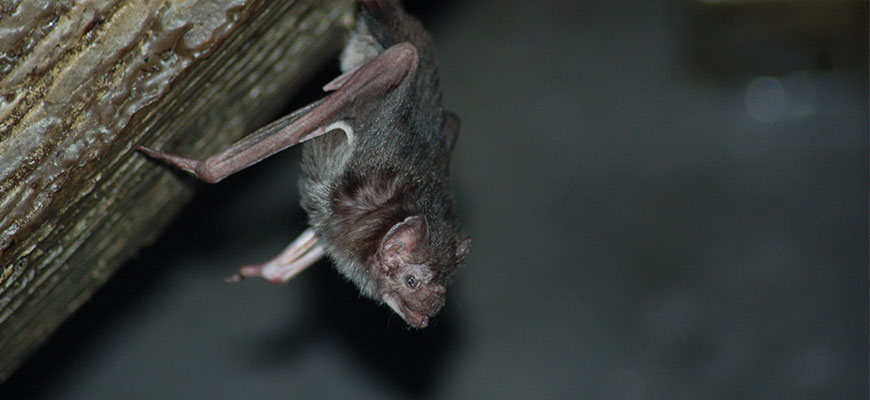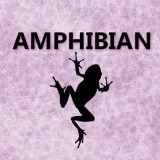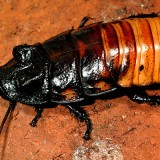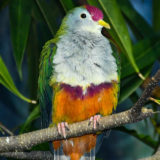RANGE
Found from Mexico to northern Argentina and Chile.
HABITAT
Are generally limited to warm climates, inhabiting both arid and humid areas in the tropics and subtropics. Tend to seek out hollows in trees, caves and fissures, abandoned wells, buildings and mine shafts. Have been found at elevations approaching as high as 7500 ft. or approximately 2,300 meters.
SIZE
Body Length: Approximately 7–9 cm (2.7–3.5 inches) Often described as
being about the length of your thumb.
Wingspan: 20.3 cm (8 inches)
Weight: Between 25–45 grams (0.881–1.6 ounces) (Babies born at around 5–7
grams)
DIET
Wild: Feed mainly on blood of various livestock species such as cows, horses and pigs. Have only rarely been known to feed on humans.
Zoo: Cow blood
REPRODUCTION
- Breed throughout the year. Male mounts female, holding on by wrapping his wings around her and using his mouth to grasp her by the neck. Copulation lasts 3–4 minutes.
- Young may be born anytime throughout the year, but births generally take place in April and May or in October and November.
- Typically only one offspring born in a year. Occasionally two births in years time.
- Normally give birth to a single offspring. Twins are rare.
- Gestation period is about 7–8 months. Young are born highly developed.
- Young feed entirely on mother’s milk for first month, weighing in at about 5–7 grams. During that month they will double in weight. During the second month they will start to feed on regurgitated blood from the mother. By the fourth month they will begin accompanying the mother on nightly hunts. They are fully grown by the 5th month. They are completely weaned from the mother by 10 months.
BEHAVIOR
Vampire Bats are social animals. Will roost alone or in small groups to colonies numbering in the several thousands.
- Large colonies will break up into smaller groups consisting of females and their young. Single males will stake out territories nearby the females and young. Males will clash frequently over territory, which can be hard-fought battles involving biting, kicking and battering with wings.
- Social bonds are enhanced by grooming, mainly between females and their young or females to females.
- Social groups may have mixture of both related animals and non-related animals. Recognition of those within own social group does seem to exist.
- Behavior described within social groups as example of reciprocal altruism, meaning animals return favors to their mutual benefit. (Example: successful hunters returning to roost will share blood meal with unsuccessful hunters through regurgitation.)
- A buddy system has been witnessed between certain pairs of bats in regards to blood-sharing relationships.
POINTS OF INTEREST
- Vampire bats are not found in the Old World, yet their name comes from legends and myths from eastern Europe of the dead that return to feed on the blood of the living. The bat was named after its blood feeding habits were discovered by European conquerors.
- Vampire bats do not actually “suck” blood, they lap it up after making a small incision on the “victim” with its sharp incisor teeth. Victims are usually some sort of livestock; such as, cows, horses or pigs.
- The typical vampire bat needs about 2 tablespoons of blood a day for survival.
- Blood sharing will take place within colonies of bats between successful hunters and those that were not so successful on a given night. The sharing is done by regurgitation. A bat can die if it doesn’t get a meal in two to three days. It is of mutual benefit for members in the social groups to help each other since on average bats are not successful 7% of the time.
- The Vampire bat’s saliva has several chemicals that act as anticoagulants, pain suppressors, and help keep the vessels open for blood flow from the inflicted wound.
- Draculin, a blood-thinning drug developed from the vampire bats saliva, is being used to help prevent strokes and heart attacks in humans. This drug is now being called Desmotaplase.
- Vampires generally find prey by flying about 3 feet off the ground and use a keen sense of smell, sound, as well as echolocation. Their hearing is so refined it can sense the breathing of a potential prey animal from some distance. Special heat sensors in the nose make it possible for the bat to find blood vessels near the surface of the skin of its victim.
- Vampires are one of the few bats that can move quite comfortably on the ground, which comes in handy since they generally do not land directly on their prey. They will actually land nearby their sleeping prey and walk or hop over to it in order not to wake it up. They will then crawl easily up on the animal and seek out a spot to make their incision. They use their sharp teeth to shave away any hair in the way and then make a small cut—usually in a leg or ankle.
- The lapping of the blood is aided by a specialized tongue that helps draw blood from the wound, somewhat like a straw. All without waking their prey. Bats will generally need about 20 minutes to get a full meal from a single wound.
- In a typical feeding the bat can consume 60% of its own weight. Only the red blood cells are needed, so an efficient digestive system converts the plasma to urine very quickly and within 2 minutes of feeding the bat is able to release the excess weight, helping to lighten the load for flight.
- Adaptations in the legs, wings and thumbs all help the vampire bat in being quite comfortable in jumping, walking and crawling on the ground and on its prey. These adaptations also make it possible for the bat to leap up off the ground and go directly into flight mode. This jump to flight has been timed to take about 30 milliseconds. Vampires are the only bats that can take off vertically.
- The only natural predators of the bats are owls and snakes. They are able to avoid attacking dogs despite the fact that canines can detect a bat’s high-frequency sounds as they approach.
STATUS
Common throughout range. Numbers being depleted in some areas where ranchers are instituting eradication programs.
REFERENCES







